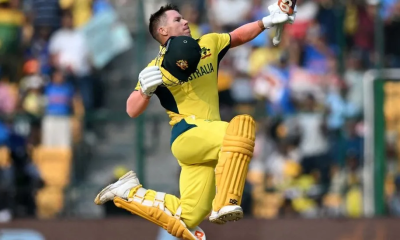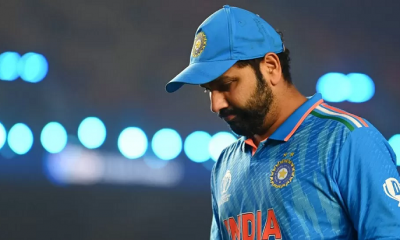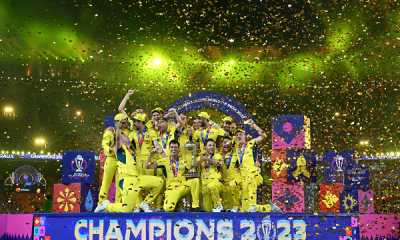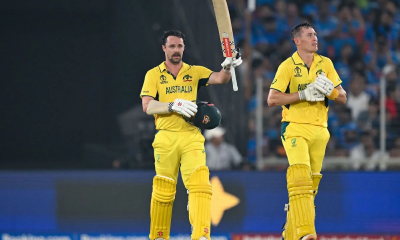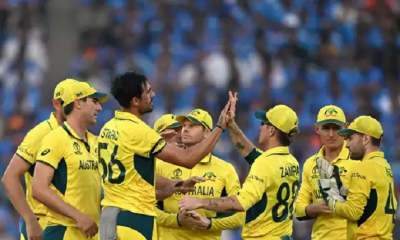Latest News
Australia prevail in low-scoring game to reach eighth World Cup final
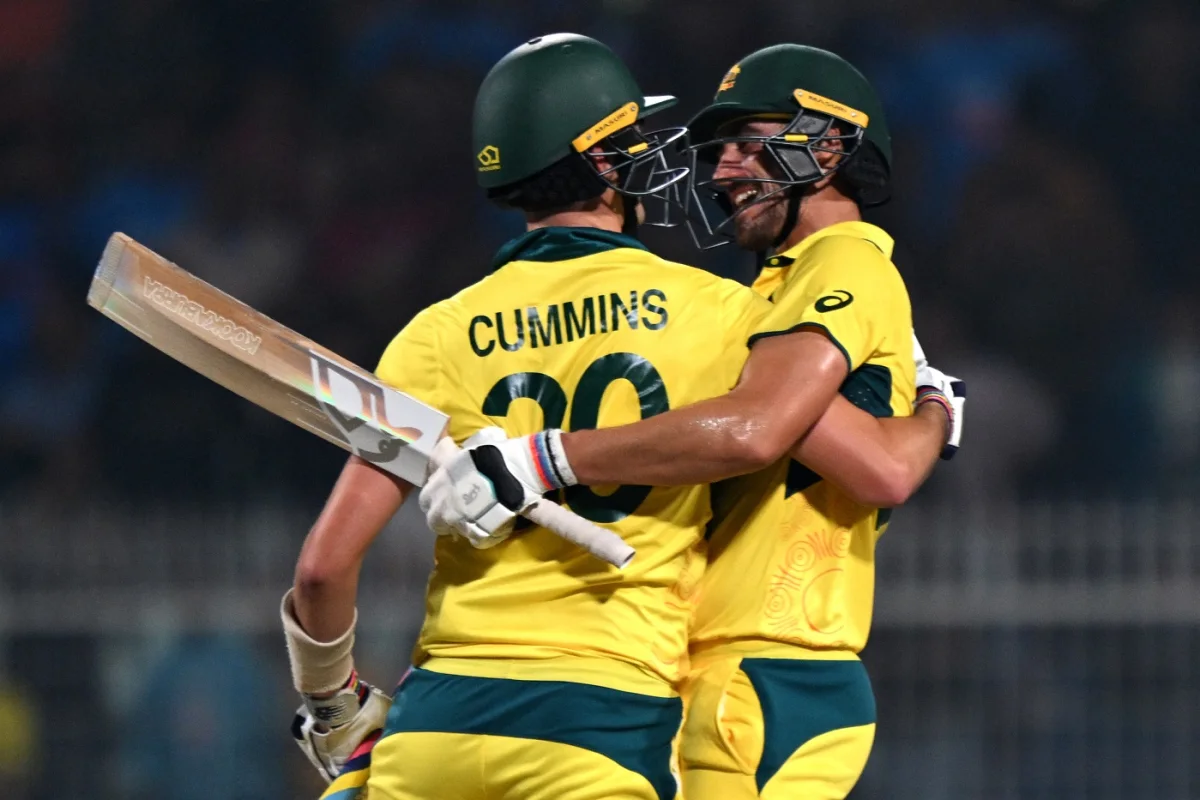
Australia made it to their eighth World Cup final with a hard-earned three-wicket win over South Africa in tricky conditions at the Eden Gardens. Pat Cummins’ side will now take on hosts India in the title clash in Ahmedabad on Sunday. For Temba Bavuma and Co. though, it was again a case of being so near yet so far in a semi-final, the fifth in five attempts that South Africa failed to get past.
David Miller’s sixth ODI hundred took Temba Bavuma’s side to 212 after opting to bat, but defending a below-par total was always going to be a challenge. Australia’s blazing start saw them gnaw away 60 runs out of the target in the first six overs, and it meant that the slowdown and collapse against spin in the middle overs counted for little. The mature hands of captain Cummins and Mitchell Starc then nudged and nurdled 22 quiet runs towards the end to get Australia over the line.
Perhaps the difference between the sides was in how they batted in the first PowerPlay. While South Africa took 53 balls to hit their first boundary, Australia took only two balls to hit their first boundary. And it came off the bat of Travis Head, the Player of the Match, who finished with 62 off 48, an innings that arguably closed the chase long before it was done. That from Head after he picked the crucial wickets of Heinrich Klaasen and Marco Jansen in the space of two balls.
The only time South Africa looked in the game was when their spinners were bowling. Aiden Markram struck with the first ball of spin that Temba Bavuma turned to, knocking over David Warner with a hint of spin. Keshav Maharaj, who was held back until the 15th over and was the last bowler into the attack, also struck with his first delivery which saw the back of hard-hitting Head.
The quiet overs that Tabraiz Shamsi and Maharaj stitched together after Head’s dismissal ultimately led to the wicket of Marnus Labuschagne, who missed an ill-advised reverse-sweep against the legspinner and was hit in front. Shamsi then went on to add the wicket of Glenn Maxwell, leaving Australia at 137/5.
It was always about bowling out Australia but the half-chances didn’t stick for South Africa. Quinton de Kock failed to hold onto a couple of tough ones behind the stumps but the dropped catch of Head by Reeza Henrdicks on 40 is what South Africa will look back on and rue. Gerald Coetzee, the bowler on that occasion, would come back and pick Steve Smith and Josh Inglis but having modest runs on the board hampered South Africa all along. But that they had as many as they did, especially from 24 for 4 was down to Miller’s extraordinary innings.
Batting under overcast skies was something even Pat Cummins admitted wanting to do, but it took only a few overs from Mitchell Starc and Josh Hazlewood to hammer home the point that batting wasn’t going to be easy against the new ball. Bavuma lasted all of five deliveries at the crease, edging behind a delivery from Starc on nought but it was Hazlewood at the other end who proved to be more of a menace.
Hazlewood’s first spell read 6-1-12-2, the two wickets being that of de Kock (caught at mid-on after a string of dot balls) and Rassie van der Dussen (edged to second slip). Starc wasn’t too far behind at the other end, bowling seven overs on the trot and picking 2 for 18 in his first spell. Markram was the other batter Starc accounted for with an edge to backward point.
So tight were the lines and lengths from the new-ball bowlers, and so good Australia’s ground fielding, that South Africa huffed and puffed to 18/2 at the end of 10 overs. In comparison, Australia were racing at 74/2 at a similar point in time in their chase.
The 95-run association between Miller and Heinrich Klaasen helped, both of whom laying into inconsistent lengths from Adam Zampa on the other side of a 45-minute rain break. Six of the eight sixes hit in the innings were off Zampa’s bowling, with both the batters hitting two each.
Just when SA looked a bit steady after having added 44 runs between overs 21 and 30, Travis Head struck gold in his first over and returned two wickets off two balls. Bowling slow and accurate, Head beat Klaasen for length and bowled him by skidding one past his outside edge. Next ball, Marco Jansen was pinned in front by one that spun in from a long way outside off. That’s how difficult and fickle the conditions were in Kolkata.
There was another 53-run rearguard between Miller and Gerald Coetzee for the seventh wicket, with Miller doing most of the scoring in that partnership. It could have gone on for longer had Coetzee reviewed the decision for caught-behind; the short ball wasn’t top-edged as the on-field umpire thought but deflected off his arm behind to the keeper.
Miller got to his hundred off 115 balls, hitting 8 fours and 5 sixes en route to a memorable innings in a World Cup knockout but he would rue not batting until the end of 50 overs. Two balls after reaching the milestone, Miller fell while trying to pull one of the many short balls that Pat Cummins bowled from round the wicket.
Brief Scores:
South Africa 213 in 49.4 overs (Miller 101; Starc 3-34, Cummins 3-51, Halewood 2-12) lost to Australia 215/7 in 47.2 overs (Head 62; Shamsi 2-42) by 3 wickets
Latest News
Argentina secures $42bn from IMF, others as it lifts currency controls

Argentina has clinched $42bn in medium-term funding from the International Monetary Fund (IMF) and two other financial institutions as it announced it is abandoning most of its tight currency controls.
The IMF’s executive board late on Friday approved a $20bn bailout package that will be doled out over the next four years, with an immediate disbursement of $12bn and another $2bn available after a review planned for June.
The World Bank also announced a $12bn support package for Argentina, and the Inter-American Development Bank (IDB) said it will provide up to $10bn in financing for the public and private sectors. Both are three-year plans.
President Javier Milei announced on Friday that he will – starting on Monday – lift most of Argentina’s strict capital and currency controls as part of agreements that secured the huge funding deals.
“Today we are breaking the cycle of disillusionment and disenchantment and are beginning to move forward for the first time,” he said on national television while flanked by his ministers. “We have eliminated the exchange rate controls on the Argentine economy for good.”
The capital controls, known in Argentina as “el cepo” or “the clamp”, were imposed by a previous administration in 2019 with the aim of preventing further financial downfall and capital flight that the country has been dealing with for years.
The controls clamped down on individuals’ ability to buy US dollars, giving rise to a black market that is widely used by citizens. They also restricted companies’ access to dollars, discouraging foreign investment that Milei needs.
The Argentinian central bank now aims to allow the peso to trade within a so-called currency band instead of firmly pegging the beleaguered currency to the dollar.
The band ranges from 1,000 to 1,400 pesos per greenback and will expand by 1 percent each month, according to the central bank.
In announcing its latest support package, the IMF said the programme is “expected to catalyse further official financing from multilateral sources” and “seeks to facilitate a timely return to international capital markets”.
“The program supports a path toward entrenching macroeconomic stability, strengthening external sustainability, and laying the foundation for stronger and more resilient growth,” it said, adding that its key pillars include “maintaining a strong fiscal anchor, transitioning towards a more robust monetary and FX regime”.
The organisation praised Argentinian authorities’ new commitment to a zero-deficit budget target, which has delivered the first fiscal surplus in almost two decades.
But to achieve the surplus, Milei has fired tens of thousands of state workers, with his overhauls hitting the population hard, including by raising poverty levels.
[Aljazeera]
Latest News
PNB detect large haul of methamphetamine and heroin in local fishing trawler intercepted by Navy

Acting on credible information, the Sri Lanka Navy launched a special operation on the high seas on 11 Apr 25, resulting in the apprehension of 06 suspects along with a local multi-day fishing trawler, believed to be involved in smuggling of narcotics.
Subsequently, the intercepted trawler was brought to the Dikkowita Harbour, where a thorough inspection was carried out with the assistance of the Police Narcotic Bureau (PNB) experts, leading to the detection of approximately 77kg and 484g of heroin and 42kg and 334g of methamphetamine (Ice).
The consignment, which had been meticulously hidden in the trawler, was handed over to the PNB for onward legal action on 12 Apr.
Latest News
Sun directly overhead Thunukkai, Olumadu, Oddusudan, Kumulamunei and Chemmalei at about 12:11 noon. today [13]

On the apparent northward relative motion of the sun, it is going to be directly over the latitudes of Sri Lanka during 05th to 14th of April in this year.
The nearest areas of Sri Lanka over which the sun is overhead today (13th) are Thunukkai, Olumadu, Oddusudan, Kumulamunei and Chemmalei at about 12:11 noon.
-

 Business7 days ago
Business7 days agoColombo Coffee wins coveted management awards
-

 News2 days ago
News2 days agoSuspect injured in police shooting hospitalised
-

 Features3 days ago
Features3 days agoRobbers and Wreckers
-

 Features5 days ago
Features5 days agoSri Lanka’s Foreign Policy amid Geopolitical Transformations: 1990-2024 – Part III
-

 Midweek Review5 days ago
Midweek Review5 days agoInequality is killing the Middle Class
-

 Features7 days ago
Features7 days agoSri Lanka’s Foreign Policy amid Geopolitical Transformations: 1990-2024 – Part I
-

 Business2 days ago
Business2 days agoSanjiv Hulugalle appointed CEO and General Manager of Cinnamon Life at City of Dreams Sri Lanka
-

 Features6 days ago
Features6 days agoA brighter future …


